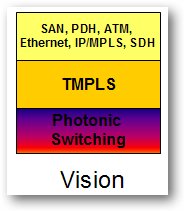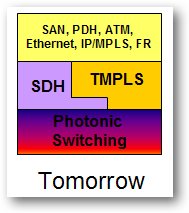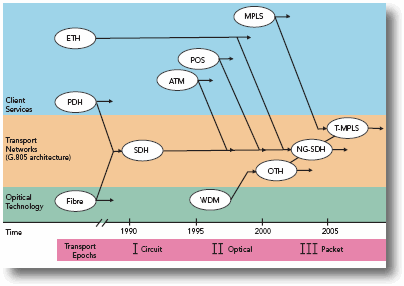PBT - PBB-TE or will it be T-MPLS?
March 2007
 Welcome to more acronym hell. In
Ethernet goes carrier grade with PBT? I looked at the history of
Ethernet and its increasing use in wide area networks. A key aspect of that was for standardisation bodies to provide the additional capabilities to make Ethernet 'carrier grade' by creating a
connection-oriented Ethernet with improved scalability, reliability and simplified management. (Picture credit:
Alcatel)
Welcome to more acronym hell. In
Ethernet goes carrier grade with PBT? I looked at the history of
Ethernet and its increasing use in wide area networks. A key aspect of that was for standardisation bodies to provide the additional capabilities to make Ethernet 'carrier grade' by creating a
connection-oriented Ethernet with improved scalability, reliability and simplified management. (Picture credit:
Alcatel)
As is the want of the network industry, not only are commercial network equipment manufacturers extremely competitive (through necessity) but the the standards bodies are as well. So we have not only the IEEE�s Provider Backbone Bridging Traffic Engineering (PBBTE) but also the ITU's Transport-MPLS (T-MPLS) activities competing in a similar space. An ITU technical overview presentation can be found here.
T-MPLS is a recent derivative of MPLS and is being defined in cooperation with the IETF. One way of looking at this could be through the now confused term layers. IP clearly operates at layer-3 while MPLS itself has been said to operate at layer-2.5 as it does not operate at a layer-2 transport level. While T-MPLS has been specifically designed to operate at the layer-2 transport level an area that the ITU focus on.
I guess the simplest way of looking at this is that T-MPLS is a stripped down MPLS standard whereby irrelevant components concerned with MPLS' support of IP connectionless service capabilities. T-MPLS is also based on the extensive standardisation work already undertaken and implemented in SDH / SONET thus representing a marriage of MPLS and SDH. The main components of T-MPLS were approved as recenly as November 2006.
The motivation behind T-MPLS is is to provide a compatible transport network that is able to appropriately support the needs of a fully converged NGN IP network while at the same time support the on-going technology enhancements taking place in the optical layer. Because MPLS has gained such popularity in the last few years, it only seems natural to enhance something was accepted, understood and more importantly is now deployed by most carriers.
So what is T-MPLS?
T-MPLS operates at the layer-2 data plane level i.e. underneath MPLS or IP/MPLS. It borrows many of the characteristics and capabilities of IETF's MPLS but focuses on the additional aspects that address the need for any transport layer to provide what is known as high availability i.e. greater than 99.999%. Some of the additions are around the following areas:
-
Clear management and control of bandwidth allocation using MPLS's Label Switched Paths (LSPs)
-
Improved control of a the transport layer's operational state through SDH-like OA&M (operations, administration, and maintenance) used for administering, and maintaining the network.
-
Improved and new network an survivability mechanisms such as protection and restoration as seen in SDH
Another key aspect, as seen in PBB-TE, is the complete separation of the control and data planes creating full flexibility for network management and signaling that will take place in the control plane. This signalling is known as generalised multi-protocol label switching (GMPLS) (also known as Automatic switched-transport network [ASTN]) and provided the same capabilities as seen in the tools used today to manage optical networks.
 T-MPLS has been designed to run over an
optical transport hierarchy (OTH) or an SDH / SONET network. I assume the OTH terminology has been adopted retrospectively to make it compatible with SDH in the same way Plesiochronous Digital
Hierarchy (PDH) was invented to cover pre-SDH technology 15 years ago. The reason for SDH / SONET support is clear as these transport technologies
are not about to go away after the significant investments made by carriers over the last 15 years. We should also not forget that the mobile world is still mainly a time division multiplexed
(TDM) world and SDH / SONET provides a bridge for those carriers in both market areas or interconnecting with mobile operators. (Picture credit:
Alcatel)
T-MPLS has been designed to run over an
optical transport hierarchy (OTH) or an SDH / SONET network. I assume the OTH terminology has been adopted retrospectively to make it compatible with SDH in the same way Plesiochronous Digital
Hierarchy (PDH) was invented to cover pre-SDH technology 15 years ago. The reason for SDH / SONET support is clear as these transport technologies
are not about to go away after the significant investments made by carriers over the last 15 years. We should also not forget that the mobile world is still mainly a time division multiplexed
(TDM) world and SDH / SONET provides a bridge for those carriers in both market areas or interconnecting with mobile operators. (Picture credit:
Alcatel)
Although T-MPLS has been defined as a generic transport standard, its early focus is clearly centred on Ethernet bringing it into potential competition with PBT / PBB-TE. It will be most interesting to see how this competition pans out.
What are differences between T-MPLS and MPLS?
Although T-MPLS is a subset of MPLS there are several enhancements. The principle on of these is T-MPLS' ability to support bi-directional LSPs. MPLS LSPs are unidirectional and both the forward and backward paths between nodes need to be explicitly defined. Conventional transport paths are bi-directional.
The following MPLS features have been dropped in T-MPLS:
-
Equal Cost Multiple Path (ECMP): Traffic can follow two paths that have the same 'cost' and is not needed in a connection oriented optical world. This is a problem in MPLS as well as it provides an element of non-predictability that affects traffic engineering activities.
-
LSP merging option: This is a real problem in MPLS anyway as traffic can be merged from multiple LSPs into a single one and losing source information. Point-2-Multi-point (P2MP) are particularly badly affected.
-
Penultimate Hop Popping (PHP): Labels are removed one node before the egress node to reduce the processing power required on the egress node. A legacy issue caused by underpowered routers that is not of concern today.
There are many other issues that need to be resolved before T-MPLS can become a robust standard set that is ready for wide scale deployment:
-
Interoperability: Interoperability between MPLS and T-MPLS control planes. There is lots of issues in this space and most activities are at an early stage.
-
Application interface: One of the main reasons ATM failed was that the majority of applications needed to be adapted to utilise ATM and it just did not happen. Although the problem with T-MPLS is limited to management tool APIs and interfaces, there are a lot of software companies that will need to undertake a lot of work to support T-MPLS. This will be quite a challenge!
T-MPLS' vision is similar to that of PBB-TE and encompasses high scalability, reduced OPEX costs, handle any packet service, strong security, high availability, high QoS, simple management, and high resiliency.
The drive to T-MPLS has not only been driven by the need to upgrade optical network management but also by the the realisation that traditional MPLS- based networks have inherited the IP characteristics of being expensive to manage from an OPEX perspective and very difficult to manage on a large scale.
This has made most carriers rather jittery. On one hand they need to follow the industry gestalt of everything-over-IP based on the assumption it will all be cheaper one day as well as enabling them to provide the multiplicity of services wanted by their customers. On the other hand, the principle technology being used to deliver this vision, MPLS, is turning out to be more expensive to manage than the legacy networks MPLS is replacing. Quite a conundrum I think and one of the principle components driving the interest in KISS Ethernet services.
The diagram below shows the ages of transport 'culminating' in T-MPLS!

Transport Ages (Picture credit: TPACK)
A good overview of T-MPLS can be read courtesy of
TPACK.
A side by side comparison of TBB-TE and T-MPLS from Meriton
It's quite easy to understand why BT would want to say this!
 Addendum:
One of the principle industry groups promoting and supporting carrier grade Ethernet is the Metro Ethernet Forum (MEF) and in
2006 they introduced their official certification programme. The certification is currently only
availably to MEF members - both equipment manufacturers and carriers - to certify that their products comply with the MEF's carrier Ethernet technical specifications. There are two levels of
certification:
Addendum:
One of the principle industry groups promoting and supporting carrier grade Ethernet is the Metro Ethernet Forum (MEF) and in
2006 they introduced their official certification programme. The certification is currently only
availably to MEF members - both equipment manufacturers and carriers - to certify that their products comply with the MEF's carrier Ethernet technical specifications. There are two levels of
certification:
MEF 9 is a service-oriented test specification that tests conformance of Ethernet Services at the UNI inter-connect where the Subscriber and Service Provider networks meet. This represents a good safeguard for customers that the Ethernet service they are going to buy will work! Presentation or High bandwidth stream overview
MEF 14: Is a new level of certification that looks at Hard QoS which is a very important aspect of service delivery not covered in MEF 9. MEF 14 provides a hard QoS backed by Service Level Specifications for Carrier Ethernet Services and hard QoS guarantees on Carrier Ethernet business services to their corporate customers and guarantees for triple play data/voice/video services for carriers. Presentation.
